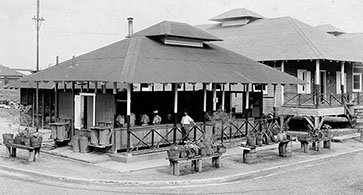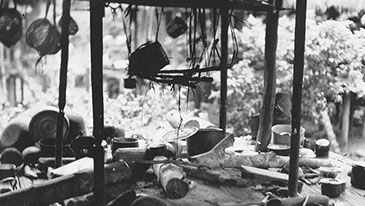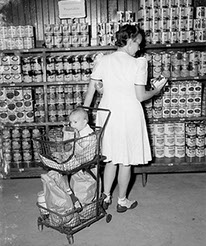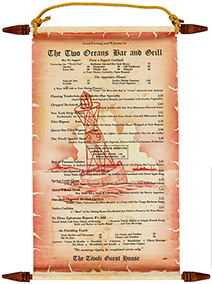Served in the Zone
curated and designed by
Elizabeth A. Bouton
As a gateway to world trade, cultures and cuisines collide in the Panama Canal. For most of the 20th century, Zonians enjoyed the blending of Panamanian, Caribbean, and American staples at the dinner table. One would visit the commissary for imported American goods and Panamanian markets for spices and produce not found in the States. Panamanian and Canal Zone restaurants still surface in conversations, sparking memories of favorite dishes and places. The foods and flavors of the Canal Zone influenced palates for generations.
“In our family, you have six generations that lived in a country overseas, and it was a different culture, in a way. There’s a slogan, the land divided, the world united, when they built the Canal. We had every culture because of all the people that came to build the Canal. Every culture in almost the entire world lived there and the stronger countries...their food and their ways were strong influences on our lives. We were introduced to so many wonderful people by living there, and you do feel different in that way. We’re not different than anybody in the U.S. because we all have stories to tell, whether you were from the Canal Zone or not.”
– Bonnie Davis Dolan
Scroll Down for Object Highlights or View the Complete Object List
Commissary
“Grocery shopping was primarily done at the Panama Canal Commissary unless you had military privileges and could also shop at the Army. Some items were in higher demand than others and so there was a tendency to hoard and a mindset that said, “if you see it get it...because the ship
will not be in for two weeks.” The manager of the commissary was usually very accommodating when people who had just returned from state-side vacations asked him to order a new product they had seen or eaten while on vacation.”
- Cheryl Russell
Community Gatherings
“You were always to remember that you were an American, American holidays, big events. Fourth of July was always a town barbecue in our town and I’m assuming the other towns did the same . . . we would barbecue a complete steer. And that was our community party . . . As the sun was going down you started this fire, get the coals, get the rock stuff and the beef was all being prepared with the secret recipes of the barbecue sauce . . . They had
beer. I do not remember keg beer as much as bottled beer. But the keg beers were around. And so by nine o’ clock in the morning when the meat was ready, the cooks had to be escorted home. Then there was all the families brought food. Like the men who were chosen to cook the meat, all of the families had their family specialty, whether it was potato salad or coleslaw, or baked beans. And set it in long tables and the whole town had a picnic.”
- Dorn Thomas

School Lunch
“Elks Club, Number 1542. They had the best food there. The Knights of Columbus had the best hamburgers. We could get two hamburgers and all for twenty-five cents. When they gave us lunch money, we usually had to walk home for lunch, because they didn’t have lunch programs at the school back then. We had to either walk home but, when they gave us money for lunch, we mostly went to Knights of Columbus because you got the better deal than going to clubhouse.”
- Gail Tully

Favorite Restaurants
“Panama had wonderful, wonderful restaurants, and I mean, not like chains. They were privately-owned restaurants and just reasonable and so delicious, lots of seafood, and then the typical food of Panama. I would say restaurants was one of the biggest things that we missed, and still do. When we go back, we look forward to going back
to some of the same restaurants and that kind of thing. For the most part most of our friends have gone, but we do have a dozen or more friends who still live in Panama who chose to stay there. So we still are able to go back and visit with them and that kind of thing. But the people of Panama are dear. They’re just real sweet people. I kinda miss that cultural mix that we don’t necessarily have up here with the Panamanian people, and the Panamanian dancing, and like I say the Panamanian food, and that kind of thing.”
- Cheryl Russell
Canal Zone Staples
Popular dishes come with multiple variations. They are similar enough, but differences among recipes are based on preference.
“First it was a Johnny Marzetti recipe and now a whole cookbook! Now, if can just track down the arroz con pollo recipe that Carman made for dinner– no olives in it.” - Bob Dryja
Johnny Marzetti
“There’s also a dish called Johnny Marzetti that originally came from somewhere in the U.S., and there’s several families that say, that was my grandmother’s recipe. No, that was my grandmother’s recipe. So everyone claims that this originated from their family . . . So it’s in all of our cookbooks, Johnny Marzetti. It’s not a Latin dish, but it’s in the Zonian culture. As a kid growing up, you would be involved in different sporting and scouting activities. . . Well, the dinners would either be fried fish or be Johnny Marzetti, ‘cause you’d make up a batch, and everyone could sit down and do it. Everybody knows Johnny Marzetti, and it’s a favorite dish.”
- Bonnie Davis Dolan and Edward Dolan

Distasteful Meals during Construction
“After confronting strikes over food, officials resolved to improve food preparation and delivery . . . Officials also built a silver section of the commissary where West Indians could buy supplies and cook them on their own. The ICC began importing large quantities of sweet potatoes, yams, and codfish from Barbados . . . Spaniards repeatedly rioted over food and conditions in the mess halls. They assaulted cooks who failed to prepare meals to their liking . . . Officials made an effort to hire Spanish cooks for the Spanish mess halls, and they imported special foods for them as well—garbanzos, tomato puree, chorizos . . . Complaints by U.S. citizens . . . found the food monotonous and poorly prepared and the service horrible . . . Nurses at Ancon Hospital in particular received such poor food they felt compelled to supplement it with commissary purchases.”
-Julie Greene, The Canal Builders, 2009
Times of Trouble
“We went down in 1946, shortly after the war ended. Of course, I was two, so I don’t really remember much, but I can remember my mother complaining a lot about not being able to get fresh food. At one point, my dad bought a bunch of live chickens, because I guess the meat was so bad. So, they got chickens and kept them in the coop behind the house. He was a farm boy,
so when they wanted chicken he went out and killed a chicken just to have good meat. It was hard to get fresh milk. I remember they kept trying to give me powdered milk and I wouldn’t drink it. Klim . . . All of us who were kids would remember it. It was nasty.”
- Carol Hellums
Influence of Neighboring Cultures
“Zonians are an amalgamation of three distinct cultures; American, Panamanian (Latin), and West-Indian. Consequently, it is only natural that Zonian cuisine is a blend of these cultures . . . Possibly the best known Panamanian meal was “ arroz con pollo” (rice and chicken), which had many variations; saffron rice or white rice, olives or no olives, peas or no peas. Empanadas often comprised my lunch when I was stationed at Ft Gulick. The Caramiñolas (meat stuffed yucca) from the Ft Amador Officer’s Club were one of my favorites . . . We were fortunate as the Townsend’s had Amy as our Jamaican help. Amy introduced us to Gungo Peas (Pigeon Peas) and rice. She added coconut milk to the rice for special flavor. Also, we’d have chayote (squash) with cheese or baked with breadcrumbs.”
- Frank Townsend

This online exhibit is based on the exhibit of the same name that was presented in the Albert H. Nahmad Panama Canal Gallery, George A. Smathers Libraries. March 3, 2018 - February 1, 2019.
All items are part of the Panama Canal Museum Collection,
Special & Area Studies Collections, George A. Smathers Libraries,
University of Florida unless noted otherwise.




